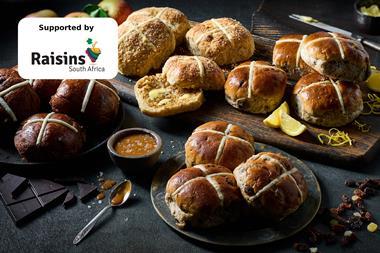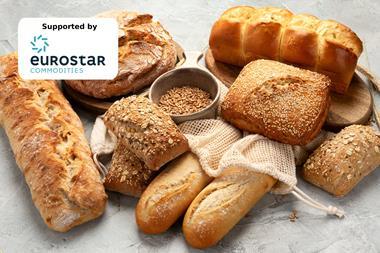How combining bakery products is continuing to open new doors for the traybakes category.
What’s better than one dessert? Two desserts in one, which is one of the key reasons hybrid bakes are on the up.
Take the Brookie slice, for example, a blend of a brownie and cookie dough rolled out by Bells of Lazonby under its We Love Cake brand. The product, a finalist in the Free-from Bakery Product category of this year’s Baking Industry Awards, taps two traybakes trends identified by Bells of Lazonby: free-from and hybrids.
“Hybrid products can create real excitement,” says Josh Boydell-Smith, head of brand and marketing at Bells of Lazonby. “Customers seem to be genuinely excited by the Brookie. The fact it’s free-from gives consumers avoiding allergens and those buying into the market as a lifestyle choice something different and indulgent.”
Other baked good manufacturers have been embracing the hybrid trend.
Ridiculously Rich by Alana, run by The Apprentice winner Alana Spencer, who recently bought Lord Sugar out of the business, makes a hybrid of a millionaire’s slice and brownie. And the Handmade Cake Co has rolled out hybrids in the shape of a cheesecake/brownie as well as a brookie.
The opportunity for further hybrid innovation is strong, suggests Michael Schofield, marketing manager at Bakels.
“In a market where consumers demand a continuous flow of new ideas, hybrids provide the perfect platform,” he says.
The trick with innovation, according to Boydell-Smith, is to add a contemporary twist to a classic, so customers can buy into a new proposition without the risk of being alienated by polarising flavours.
“Raspberry ripple seems to be making a comeback and the inclusion of popular confectionery brands is also making its way into traybakes,” he notes.
Schofield says the line between bakery and confectionery continues to blur, with retro brands making their way into baked goods. “Traybakes and slices are perfect for these brand collaborations.,” he adds.
However, a baker considering using branded confectionery in a product also needs to be aware of the risk of infringing a registered trade mark (see Legal, p15).
Jacqui Passmore, marketing manager at Dawn Foods, notes that brownies work particularly well with added extras, such as salted caramel fillings and toppings including millionaire’s shortbread pieces.
But combining two different bakes is not without its challenges. There’s the risk of a hybrid becoming gimmicky, according to Emma Goss-Custard, director of free-from slices brand Honeybuns.
“To avoid disappearing down creative rabbit holes, we need to listen to customers and deliver something relevant, fun and delicious,” she suggests, adding that when creating new Honeybuns products, she looks to the hot beverage market for flavour and blending techniques.
The chosen fusion elements should be identifiable favourites, but presented in a new way, advises Nigel Cave, development manager at The Handmade Cake Co brand owner Mademoiselle Desserts.
“The two elements must complement each other, making the most of the best parts of each. A good hybrid will challenge the customer’s perceptions of the dessert with flavours and textures they wouldn’t normally associate.”
But, he warns, it takes skill to blend two traditional formats into one, ensuring the product is still balanced and each element is still recognisable. “Contrast is the key to success – choose something crunchy or crisp to marry with a sponge or fudge texture.”
And, like all successful marriages, a hybrid will take time, perseverance and possibly an awful lot of patience.
Mr Kipling: staying the giant of slices
Mr Kipling continues to dominate the slices market, with more than a 50% share and sales up 7.7% year on year [Kantar 2019].
Growth has been driven by a mix of NPD, above-the-line support, a packaging revamp and strong in-store activity, according to brand owner Premier Foods.
Limited-edition ranges tapping consumer trends have also been integral to the growth, according to Matthew Bird, Premier’s brand director for Sweet Treats. These include Dragon Slices, which the cake brand launched earlier this year, as well as Unicorn Slices, which are now a permanent part of the range.
“Not only have the limited-edition ranges allowed us to capitalise on new and developing trends, such as unicorns and dragons, they have also tapped established consumer preferences like the books by Roald Dahl,” adds Bird.
The limited-edition Roald Dahl range of cakes and slices first launched in the summer of 2018 and relaunched with additional lines earlier this year. It included SKUs such as James’ Peach Slices and The BFG’s Frobscottle Fancies, which were exclusive to selected retailers.
The partnership with the Roald Dahl Story Company in 2018 drove £4m in retail sales value and contributed to the category’s overall growth of 1.4% over the summer period, states Premier Foods. “The limited-edition range
also brought incremental shoppers to the brand at a time of year when sales of ambient cake tend to slow,” adds Bird.
Aside from fantasy creatures, Mr Kipling has tapped the growing market of consumers looking for healthier alternatives, as well as meeting government targets with the launch of its reduced sugar slices.
These launched in two popular flavours – Angel and Chocolate – and contain 30% less sugar and 100 calories per slice.
“The Angel Slice is a best-seller within the Mr Kipling range, worth £20m across two popular pack formats [IRI, 52 w/e February 2019]. The launch of a lower-sugar variant offers consumers a healthier alternative from a well-known brand that will help increase sales,” explains Bird. “Fifty per cent of the spend generated by these two sugar-reduced slices since launch has been incremental to the category.”


























No comments yet